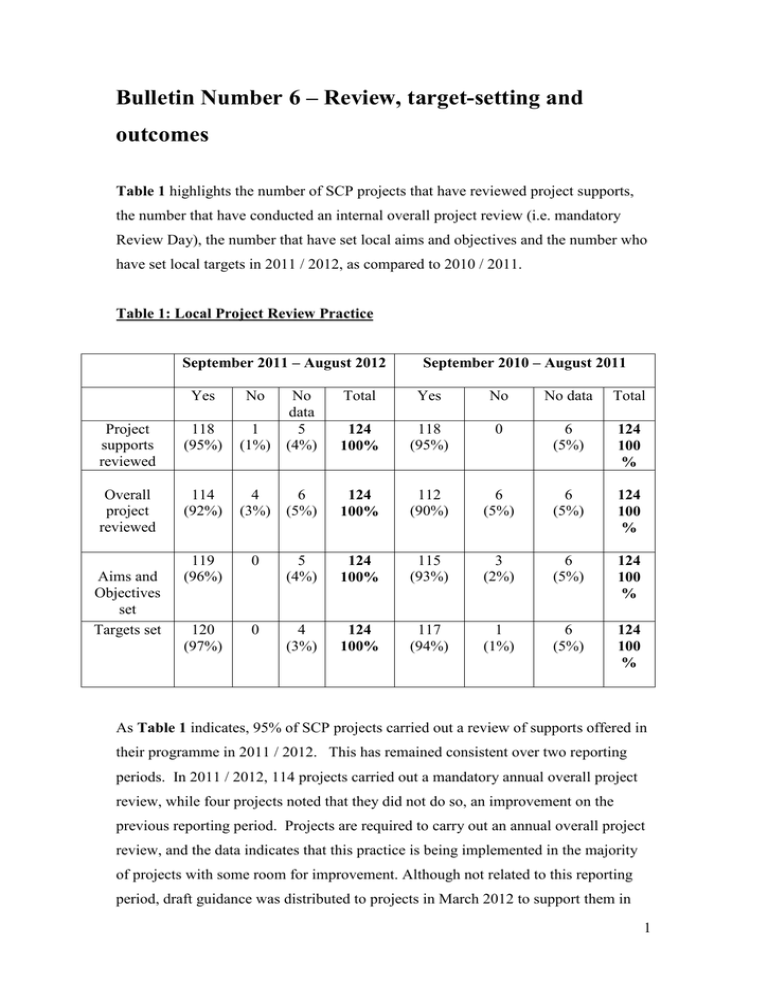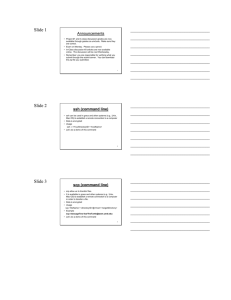Bulletin Number 6 – Review, target-setting and outcomes
advertisement

Bulletin Number 6 – Review, target-setting and outcomes Table 1 highlights the number of SCP projects that have reviewed project supports, the number that have conducted an internal overall project review (i.e. mandatory Review Day), the number that have set local aims and objectives and the number who have set local targets in 2011 / 2012, as compared to 2010 / 2011. Table 1: Local Project Review Practice September 2011 – August 2012 Yes No Project supports reviewed 118 (95%) Overall project reviewed Aims and Objectives set Targets set September 2010 – August 2011 Total Yes No No data Total 1 (1%) No data 5 (4%) 124 100% 118 (95%) 0 6 (5%) 124 100 % 114 (92%) 4 (3%) 6 (5%) 124 100% 112 (90%) 6 (5%) 6 (5%) 124 100 % 119 (96%) 0 5 (4%) 124 100% 115 (93%) 3 (2%) 6 (5%) 124 100 % 120 (97%) 0 4 (3%) 124 100% 117 (94%) 1 (1%) 6 (5%) 124 100 % As Table 1 indicates, 95% of SCP projects carried out a review of supports offered in their programme in 2011 / 2012. This has remained consistent over two reporting periods. In 2011 / 2012, 114 projects carried out a mandatory annual overall project review, while four projects noted that they did not do so, an improvement on the previous reporting period. Projects are required to carry out an annual overall project review, and the data indicates that this practice is being implemented in the majority of projects with some room for improvement. Although not related to this reporting period, draft guidance was distributed to projects in March 2012 to support them in 1 the process of project review. Information will be issued to projects in due course to further support them in implementing a more standardised approach to project review. Ninety-six percent of projects set aims and objectives. This also represents a significant, consistent and welcome improvement on previous reporting periods. Projects are also obliged to set local project targets, as per the most recent Retention Plan, and ninety-seven percent of projects did so in 2011 / 2012. The significant increase over the previous reporting period indicates that projects are improving practice in relation to setting targets and measuring outcomes, perhaps linked to ongoing and enhanced DEIS planning that necessitates the development and monitoring of targets in a number of relevant and related areas. Target setting and outcomes As indicated, 120 projects set targets and recorded progress on targets being met (see Examples 1 to 4 overleaf) over the reporting period. A range of targets is set at local level. Of the 120 projects that stated that targets had been set locally, 6 projects did not describe the targets set (including one project whose targets where incomplete and two projects who provided targets for different reporting periods). In relation to outcomes, a more detailed analysis was carried out during this reporting period on: a) Progress on outcomes stated b) The evidence provided to support whether outcomes were achieved / not achieved The outcome of this analysis indicates that the practice is quite mixed. While projects have improved their practice in setting targets, the ability to demonstrate progress on outcomes is patchy, with the majority of projects only able to demonstrate clear progress on some of the targets set. Furthermore, some projects that have set targets with a numerical component (e.g. percentage increase, number of days etc.) struggle to report the numerical change from the target stated. Equally, some projects that set non-numerical targets find it hard to provide specific and, therefore, worthwhile information on whether an outcome has been achieved or not. 2 In terms of providing the evidence to support whether outcomes were achieved / not achieved, again the practice is mixed. Some projects indicated very clearly their sources of evidence and their approaches to data collection whereas, in other cases, it was challenging to ascertain the link between the target, the data collection/evidence base and outcomes. It is clear that further support is required to assist projects with this element of practice (see note above on draft project review guidance distributed to projects in 2012). As an interim means of demonstrating good practice, examples identified in projects of effective target setting, measurement / monitoring / data collection and progress on outcomes are presented below. These examples identified below demonstrate a consistent approach to target-setting, measurement / monitoring and stated progress across the three domains. Other projects demonstrated good practice across one or two domains, but not all three. Example 1: SCP project in rural town with seven primary schools and one postprimary school Targets Set Measurement / monitoring Stated Progress 1. Improve the school attendance of the SCP target group by 10% (1011). Through regular feedback to LMC as to progress. Through a comparative study of attendance figures from year to year or term to term 12 target students receiving regular SCP mentoring had increased their attendance. The average days absent this year is 1.95 as compared to 2.39 last year. An improvement of over 18.4%, which is over our projected target. 2. Support SCP students to sit their state exams 3. Maintain 100% transfer from primary to post-primary. Students attended their mentoring regularly. Some reported improved grades in their mocks, and increased participation in class. All last years 6th class group transferred to first year 4. Encourage full attendance at School Transfer Programme week in August. Through a comparative study of results from beginning and end of intervention or from mock exam results to actual exam results Through tracking each target student in their transfer from primary to post primary and checking at the end of term 1 to see if they are still enrolled Through attendance record and review with stakeholders 5. Maintain good communication between SCP and schools. Review questionnaires and other feedback from schools The transition programme that was developed last year by SCP staff was delivered to target students in need of intensive support. SCP were involved in the school induction programme that all target students attended. This year schools approached SCP re. more workshops and looking for help with issues. There was 3 positive feedback from schools re. improved communication Better communication regarding time and duration of suspension due to check and connect system. Still some improvements to be made Attendance in five cases improved. Target students were referred to other clubs and programmes. A Latvian mentor was employed by SCP. New programmes were established e.g. the social clubs, tailored specifically to their needs A variety of new programmes were devised to directly respond to the needs of the target students. These programmes led to increased attendance, reduced stress, increased skill and improved relationships. A high volume of contact with parents. A Parents Plus course was delivered with 2 SCP parents attending. And also delivered in the home with two others. 6. Request prompt communication with schools regarding suspensions so as to provide early intervention and support. Comparative study of communication at start and end of year. End of year review 7. Continue to provide supports to travellers and members of other ethnic minorities that respond directly to their needs. Client review / management report / feedback from schools / feedback from EWO re participation 8. Provide high quality mentoring and personal development programmes which support the varying needs of the target student regarding behaviour and social skills. Feedback from target students. Proof of attendance and topics covered. Progress tracked completed to monitor progress. Feedback from schools 9. Ensure that parents are aware of the services and activities provided by the SCP. 10. Continue to implement the revised profiling system, and update or adapt files in response to changes in department guidelines. 11. Offer a range of services to all SCP schools to ensure provision in rural areas. Documenting of the volume of home visits. Recording of referrals to other agencies and any progress. Documenting the number of parents attending courses etc. Feedback from parents. Regular file audit. Immediate response to any changes as per changes in government department. Staff targets set and monitored per term with regard to managing files and paperwork Needs analysis. Comparative analysis at the end of the year of how many requested services were implemented and helps and hindrances to same 12. Continue to provide mental health workshops to both boys and girls in second year post primary. Programme taking place. Number of participants. Topics covered. Feedback from participants. Review with staff involved. 13. Continue to target and prioritise those students who are out of school and provide relevant supports. Accurate information regarding out of school students. Level of intervention intensive to facilitate a return to school 14. Support target students, who have accessed SCP services in the past, in their progression after leaving school and refer them to the relevant agencies Consult with schools regarding literacy and numeracy programmes in place. Do develop or implement an existing programme if requested by schools or target parents. Documenting a number of relevant calls to the office actions taken in each case Continued and improved links with target students which provide the opportunity for referral to other agencies when required Report on needs analysis. Review with target student of any action implemented. Schools have recognised the role of SCP and have helped them source training. At the end of September 2012 SCP will have staff trained to deliver the ‘Catch Up’ programme. 15. A full review of files took place. Improvements were made to the system to improve quality Increased uptake. Primary schools happy with the level of SCP support. New programmes being requested. All programmes supporting SCP students with the classroom Workshop was delivered. All SCP students in the year attended. Positive image for SCP in the school as a result. Mental health awareness increased All have received SCP support. Those receiving intensive support are attending their support regularly 4 Example 2: SCP project in rural town close to urban centres with four primary schools and 2 post-primary schools 1. 2. 3. 4. Targets Set Measurement / monitoring Stated Progress Improve in the academic year 2011/12 the attendance of SCP group. Comply with Ed. Welfare Act in respect of #retention to JC Improve level of achievement and participation of SCP target group. Tracking attendance. NEWB returns. Cluster meetings (SCP, HSCL, EWO) Measures of retention rates to JC and LC Assessment feedback – individual, parent, teachers. Record of attendance at SCP supports Evaluation of interagency strategies. Pastoral care focus Reduction in numbers of chronic non-attendance and days lost through absence Increased level of JC and LC completion Increased levels of attainment and social interaction Increase partnership with others. Increased participation and collaboration Example 3: SCP project in Dublin inner city with four primary schools and two post-primary schools Targets Set Measurement / monitoring Stated Progress 1. Improvement on overall school attendance and retention (to incl. punctuality). Attendance monitors. SCP Coordinator linked in with attendance monitors in each school 2. To raise students' levels of literacy. Analysis of student / parent / teacher consultation. SCP Coordinator made links with literacy personnel in each school. SCP Co-ordinator worked with schools to analyse scores and record each term 3. To raise students' levels of numeracy. Standardised testing. Teacher reporting. SCP pupil profiles 4. Raise self-esteem of young people in and out of school and during holiday time away from school. SCP Co-ordinator linked with teachers and HSCL during evaluations. SCP Co-ordinator Reports on attendance of targeted students analysed each term by SCP Co-ordinator and as a result support and interventions put in place as necessary. Attendance and retention did improve in line with national averages reported. Attendance improved overall for students Progress in literacy is on-going. Scores that were recorded showed significant improvements among students in their reading levels and written work. Results of student / parent / teacher consultation was presented at Annual Review. Continued support of literacy in holiday and after school camps is being offered to the SCP target group Progress is numeracy is on-going. Teacher reports have given valuable insight. Allocating time for Maths games has been a great success with students. Results of student / parent / teacher consultation was presented at Annual Review. Continued support of numeracy in holiday and after school camps is being offered to the SCP target group Through the use of student evaluation of supports and interventions used we gained useful 5 and teacher surveyed students re supports and interventions. Active communication with both students and parents about what needed to be done in order to make our school a happy learning environment Schools kept a thorough record of students transferring. SCP Coordinator carried out student, teacher and parent consultation in collaboration with HSCL in relation to transfer 5. Students will transfer from Junior Primary to Senior Primary to Secondary School and be retained to Junior Certificate level and beyond. 6. Engaging parents in the retention of their children Use of a school log of meetings including home visits. SCP Coordinator worked in collaboration with HSCL in conducting surveys about the overall support and interventions offered to their child 7. Work in partnership with the relevant statutory, community and voluntary agencies to retain students in education. Worked with other agencies. We looked at their impact on the students and how we should move forward. insight into what was going well and what we needed to work on. We did get parent questionnaires from some parents this year but we hope to continue with this next year More emphasis has been placed on students being retained to JC level and beyond. Annual presentation of retention figures has been implemented as part of the project review. Schools are keeping thorough records and interviewing parents of vulnerable students in order to make sure transfer is as seamless as possible Parents more involved in planning the way forward for their child. Student sent home Certificates of Achievement. Positive news for parents about their child. Great emphasis has been placed on parental opinion. Greater communication between home and school regarding targeted students. We continue to build relationships with parents of more marginalised families Surveys and evaluations carried out for annual progress review and presented on Review day. Extended meetings held to assess usefulness of resources – what is most effective and what do we need to change? Example 4: SCP project in rural town with two primary schools and one postprimary school Targets Set Measurement / monitoring Stated Progress 1. Improve attendance of targeted students. Improvement in attendance with over 50% of target students making end of term reward trips 2. Support all targeted students through developing positive selfesteem with the aim that they complete the Junior Certificate. Increase the number of target students participating in the programme Baseline school roll October 2009. Attendance secretary reports. Attendance tracking database. Progress reports. Compare data from previous years. Attendance reports. Progress reports 3. 4. Offer an intensive transfer programme to all target students Compare data from previous year. Monitor attendance at SCP supports. Progress reports Monitor target students progress. Link with parents, teachers and other staff re progress 100% JC achievement. Self esteem difficult to measure but we aim to provide as much positive reinforcement as possible There has been an increase in the number of target students on the attendance programme and in the homework clubs Intensive transfer programme offered and feedback from the first years was very positive 6



